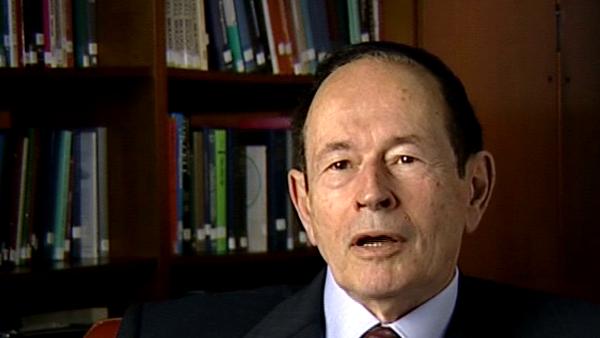NEXT STORY

The importance of the Neurosciences Institute
RELATED STORIES

NEXT STORY

The importance of the Neurosciences Institute
RELATED STORIES


|
Views | Duration | |
|---|---|---|---|
| 41. Michael Merzenich and stroke patients | 537 | 04:18 | |
| 42. Anosognosia | 513 | 01:51 | |
| 43. The importance of the Neurosciences Institute | 506 | 05:09 | |
| 44. The effectiveness of the Neurosciences Institute | 386 | 02:16 | |
| 45. Proving invertebrates sleep | 444 | 03:22 | |
| 46. Brain based device | 537 | 04:01 | |
| 47. Hippocampus and memory | 584 | 04:33 | |
| 48. Philosophy and consciousness: Galileo and Descartes | 1 | 648 | 01:48 |
| 49. Putting the mind back in nature | 1 | 662 | 03:17 |
| 50. A theory of consciousness: The thalamus | 1 | 700 | 03:31 |


Well, there's another kind of disease related to that which is that, if you have a more extensive stroke, you have something called anosognosia, in which you don't even realize that you're paralyzed on your left side. So let me tell you the story of the neuropsychologist and neurologist Bisiach in Milan. We had a patient of this kind who had anosognosia, had a massive stroke on the right side and he came up and he said, 'Look, I've got these two cubes, they're identical; I'm going to put this one in your left hand and will take it in my left hand the other one. Now copy what I've done.' And he moved his hand around. The patient said, 'There, Doc, I've done it.' He said, 'No, you haven't.' He said, 'Sure I have.' He took the patient's hand and put it in his right visual field and said, 'Whose hand is this?' And the patient said, 'Yours.' And he said, 'I can't have three hands.' And the patient said, 'Doc, it stands to reason, if you've got three arms you have to have three hands.'
Now, that theory is a very deep theory that would explain that, and we don't really have that theory yet. It would be almost like what Freud said... would be the equivalent of what he called Anna O – a kind of paradigm case that, if you explain that, you have the whole picture. So the brain is embodied and it depends in its dynamics on the kind of body you have. But the second thing is: the brain and the body are in the world, and the signals that go to your brain, unlike what we do in our laboratories, are enormously diverse and complex. If you came in this room ten times and I changed the chairs or the... the table, you don't really believe that you keep every single detail of the last time in your mind, yet the number and diversity of different kinds of inputs, even at the same place, is absolutely astonishing. So how can you put a brain theory together unless you consider all of these things?
US biologist Gerald Edelman (1929-2014) successfully constructed a precise model of an antibody, a protein used by the body to neutralise harmful bacteria or viruses and it was this work that won him the Nobel Prize in Physiology or Medicine in 1972 jointly with Rodney R Porter. He then turned his attention to neuroscience, focusing on neural Darwinism, an influential theory of brain function.
Title: Anosognosia
Listeners: Ralph J. Greenspan
Dr. Greenspan has worked on the genetic and neurobiological basis of behavior in fruit flies (Drosophila melanogaster) almost since the inception of the field, studying with one of its founders, Jeffery Hall, at Brandeis University in Massachusetts, where he received his Ph.D. in biology in 1979. He subsequently taught and conducted research at Princeton University and New York University where he ran the W.M. Keck Laboratory of Molecular Neurobiology, relocating to San Diego in 1997 to become a Senior Fellow in Experimental Neurobiology at The Neurosciences Institute. Dr. Greenspan’s research accomplishments include studies of physiological and behavioral consequences of mutations in a neurotransmitter system affecting one of the brain's principal chemical signals, studies making highly localized genetic alterations in the nervous system to alter behavior, molecular identification of genes causing naturally occurring variation in behavior, and the demonstration that the fly has sleep-like and attention-like behavior similar to that of mammals. Dr. Greenspan has been awarded fellowships from the Helen Hay Whitney Foundation, the Searle Scholars Program, the McKnight Foundation, the Sloan Foundation and the Klingenstein Foundation. In addition to authoring research papers in journals such as "Science", "Nature", "Cell", "Neuron", and "Current Biology", he is also author of an article on the subject of genes and behavior for "Scientific American" and several books, including "Genetic Neurobiology" with Jeffrey Hall and William Harris, "Flexibility and Constraint in Behavioral Systems" with C.P. Kyriacou, and "Fly Pushing: The Theory and Practice of Drosophila Genetics", which has become a standard work in all fruit fly laboratories.
Tags: Edoardo Bisiach
Duration: 1 minute, 51 seconds
Date story recorded: July 2005
Date story went live: 24 January 2008